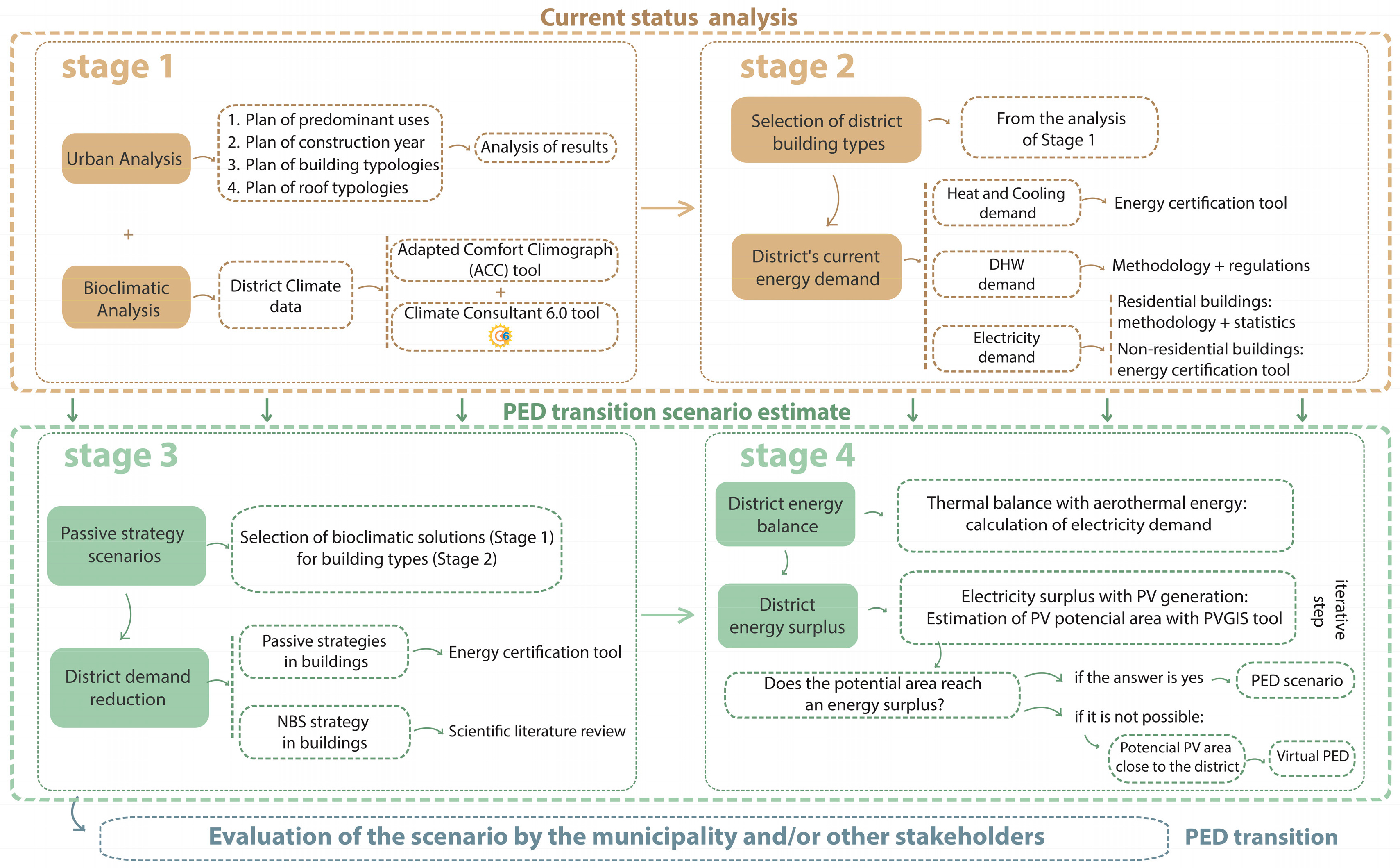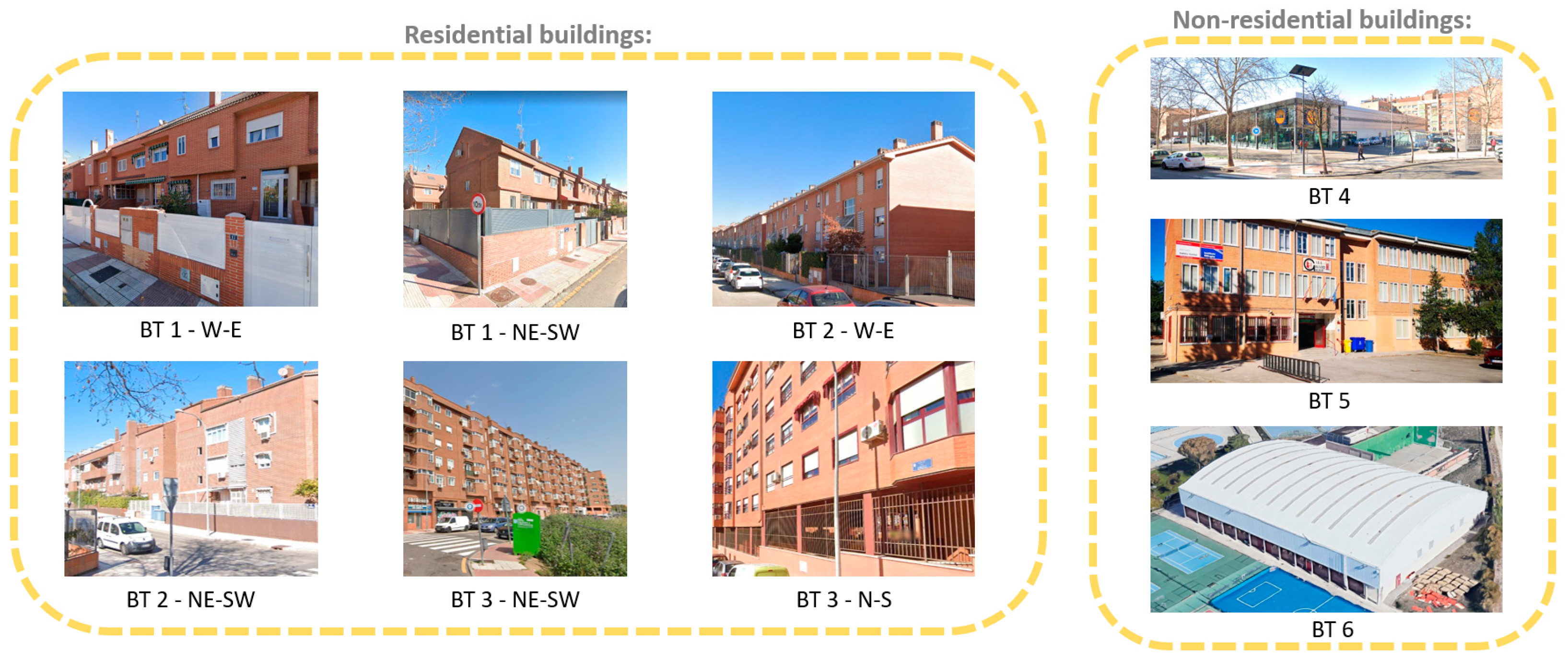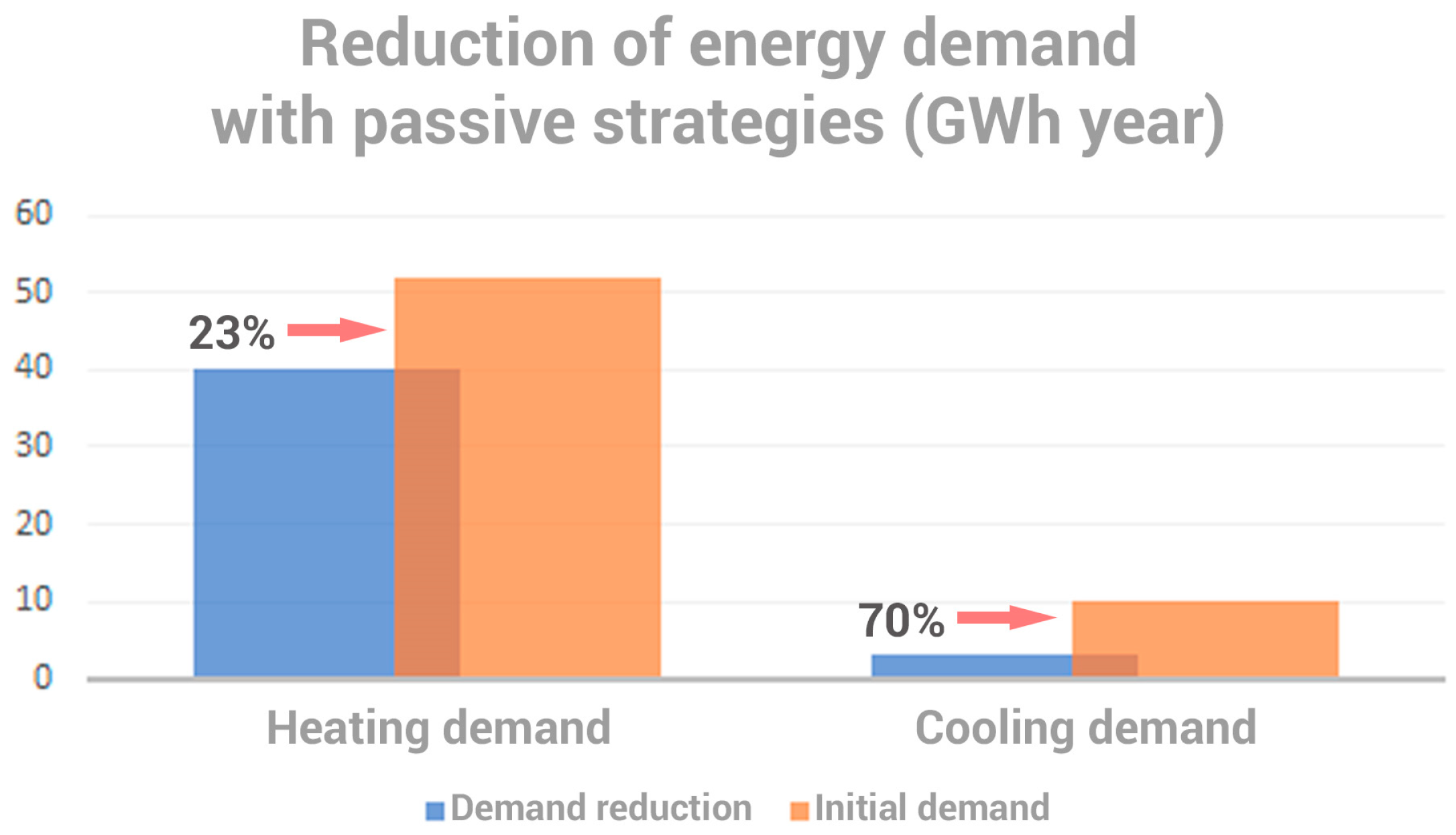Technical Feasibility for the Boosting of Positive Energy Districts (PEDs) in Existing Mediterranean Districts: A Methodology and Case Study in Alcorcón, Spain
Abstract
:1. Introduction
2. Material and Methods
2.1. Stage 1: Urban and Bioclimatic Analysis
2.1.1. Urban Analysis
- Predominant uses: The identification of the main category of use of a building (e.g., mixed-use, residential, industrial, commercial) facilitates the definition of the district’s energy demand and the selection and design of possible intervention strategies for its reduction.
- Construction year: Many characteristics of a building depend on its year of construction. In particular, the building’s age can indicate a good deal about its materials and construction techniques that can influence its energy demand [23].
- Building typologies: Architectural forms and typologies can influence the correct use of environmental resources, such as sun and wind, etc., and building heights can also impact other neighboring buildings, e.g., with their shade.
- Roof typologies: The analysis of the building’s roof identifies areas and can provide estimates for their potential for renewable energy and green roof installation.
2.1.2. Bioclimatic Analysis
- District climate data:
- 2.
- Bioclimatic climograph
2.2. Stage 2: Calculation of the Energy Demand of the District in the Current Situation
2.3. Stage 3: Identification of Passive Strategies and Calculation of the Demand Reduction of the District
2.4. Stage 4: Calculation of Renewable Energy Generation Potential, Balance and Surplus of the PED Scenario
- The high electrification of the building stock in terms of thermal energy generation because of the high installation of heat pumps in recent years [23];
3. Results
3.1. Stage 1 Urban and Bioclimatic Analysis
3.1.1. Urban Analysis
3.1.2. Bioclimatic Analysis
- District climate data:
- ACC Climograph:
- Climate Consultant:
3.2. Stage 2: Calculation of the Energy Demand of the District in the Current Situation
3.2.1. Estimation of Heating and Cooling Energy Demand
3.2.2. DHW Energy Demand
3.2.3. Electric Energy Demand
3.3. Stage 3: Identification of Passive Strategies and Calculation of the Demand Reduction of the District
3.3.1. Passive Strategies (PS) in Buildings
3.3.2. Nature-Based Strategy (NBS) in Buildings
3.4. Stage 4: Calculation of Renewable Energy Generation Potential, Balance and Surplus of the PED Scenario
Active Strategies Scenario and Estimation of Energy Surplus:
4. Discussion and Future Development
5. Conclusions
Author Contributions
Funding
Institutional Review Board Statement
Informed Consent Statement
Data Availability Statement
Conflicts of Interest
Abbreviations
| Acronym | Name |
| TDHeat | District Thermal Heating Demand (GWh year) |
| TDCool | District Thermal Cooling Demand (GWh year) |
| TDDHW | District Thermal DHW Demand (GWh year) |
| DHeat | Thermal Heating Demand (kWh/m2 year) |
| DCool | Thermal Cooling Demand (kWh/m2 year) |
| DDHW | Thermal DHW Demand (kWh/m2 year) |
| DED | District Electricity Demand (GWh year) |
| ED | Electricity Demand (kWh/m2 year) |
| TDRHeat | District Thermal Heating Demand Reduction (GWh year) |
| TDRCool | District Thermal Cooling Demand Reduction (GWh year) |
| COP | Coefficient of performance |
| EEHeat+DHW | Electrical Energy for Heating and DHW |
| EECool | Electrical Energy for Cooling |
| PVG | Photovoltaic generation potential (GWh year) |
References
- Ritchie, H.; Roser, M.; Rosado, P. CO₂ and Greenhouse Gas Emissions. Available online: https://ourworldindata.org/co2-and-greenhouse-gas-emissions (accessed on 10 February 2023).
- United Nations. The Paris Agreement. Available online: https://climate.ec.europa.eu/eu-action/international-action-climate-change/climate-negotiations/paris-agreement_en (accessed on 20 August 2023).
- European Commission. A European Green Deal. Available online: https://commission.europa.eu/strategy-and-policy/priorities-2019-2024/european-green-deal_en (accessed on 7 June 2023).
- United Nations. The Sustainable Development Agenda. Available online: https://www.un.org/sustainabledevelopment/development-agenda/ (accessed on 7 June 2023).
- European Commission. Renovation Wave. Available online: https://energy.ec.europa.eu/topics/energy-efficiency/energy-efficient-buildings/renovation-wave_en (accessed on 7 June 2023).
- European Commission. REPowerEU Affordable, Secure and Sustainable Energy for Europe. Available online: https://commission.europa.eu/strategy-and-policy/priorities-2019-2024/european-green-deal/repowereu-affordable-secure-and-sustainable-energy-europe_en (accessed on 7 June 2023).
- SET-Plan Working Group 3.2. Europe to Become a Global Role Model in Integrated, Innovative Solutions for the Planning, Deployment, and Replication of Positive Energy Districts. 2018. Available online: https://jpi-urbaneurope.eu/wp-content/uploads/2021/10/setplan_smartcities_implementationplan-2.pdf (accessed on 20 September 2021).
- JP Urban Europe. Available online: https://jpi-urbaneurope.eu/ (accessed on 15 June 2023).
- EERA JPSC. Available online: https://www.eera-sc.eu/ (accessed on 25 July 2023).
- Albert-Seifried, V.; Murauskaite, L.; Massa, G.; Aelenei, L.; Baer, D.; Krangsås, S.G.; Alpagut, B.; Mutule, A.; Pokorny, N.; Vandevyvere, H. Definitions of Positive Energy Districts: A Review of the Status Quo and Challenges. In Sustainability in Energy and Buildings 2021; Springer: Singapore, 2022. [Google Scholar] [CrossRef]
- Moreno, A.G.; Vélez, F.; Alpagut, B.; Hernández, P.; Montalvillo, C.S. How to Achieve Positive Energy Districts for Sustainable Cities: A Proposed Calculation Methodology. Sustainability 2021, 13, 710. [Google Scholar] [CrossRef]
- Civiero, P.; Pascual, J.; Arcas Abella, J.; Salom, J. Innovative PEDRERA Model Tool Boosting Sustainable and Feasible Renovation Programs at District Scale in Spain. Sustainability 2022, 14, 9672. [Google Scholar] [CrossRef]
- White Paper on Reference Framework for Positive Energy Districts and Neighbourhoods. Available online: https://jpi-urbaneurope.eu/ped/ (accessed on 10 July 2023).
- Brozovsky, J.; Gustavsen, A.; Gaitani, N. Zero Emission Neighbourhoods and Positive Energy Districts—A State-of-the-Art Review. Sustain. Cities Soc. 2021, 72, 103013. [Google Scholar] [CrossRef]
- European Commission. Horizon Europe-Work Programme 2023-2024 Climate, Energy and Mobility; European Commission: Luxembourg, 2023.
- Bylund, J.; Gollner, C.; Jäger, M.; Klaming, G.; Noll, M.; Riegler, J.; Rodenstedt, A.; Wallsten, B. European Partnership. Driving Urban Transitions to a Sustainable Future Roadmap. Available online: https://dutpartnership.eu/ (accessed on 15 June 2023).
- PED-EU-NET. COST Action CA19126. 2020. Available online: https://pedeu.net/ (accessed on 7 June 2023).
- IEA. Annex 83 PED. Available online: https://nachhaltigwirtschaften.at/en/iea/technologyprogrammes/ebc/iea-ebc-annex-83.php#:~:text=IEA%20EBC%20-%20Annex%2083%20-%20Positive%20Energy,agile%2Fflexible%20enough%20to%20respond%20to%20energy%20market%20fluctuations (accessed on 15 June 2023).
- Guarino, F.; Bisello, A.; Frieden, D.; Bastos, J.; Brunetti, A.; Cellura, M.; Ferraro, M.; Fichera, A.; Giancola, E.; Haase, M.; et al. State of the Art on Sustainability Assessment of Positive Energy Districts: Methodologies, Indicators and Future Perspectives. In Sustainability in Energy and Buildings 2021; Smart Innovation, Systems and Technologies; Springer: Singapore; Volume 263, pp. 479–492.
- De León, L.; Mora, D.; Carpino, C.; Arcuri, N.; Chen Austin, M. A Reference Framework for Zero Energy Districts in Panama Based on Energy Performance Simulations and Bioclimatic Design Methodology. Buildings 2023, 13, 315. [Google Scholar] [CrossRef]
- Vandevyvere, H.; Ahlers, D.; Wyckmans, A. The Sense and Non-Sense of PEDs—Feeding Back Practical Experiences of Positive Energy District Demonstrators into the European PED Framework Definition Development Process. Energies 2022, 15, 4491. [Google Scholar] [CrossRef]
- Shao, L.; Liao, W.; Li, P.; Luo, M.; Xiong, X.; Liu, X. Drivers of Global Surface Urban Heat Islands: Surface Property, Climate Background, and 2D/3D Urban Morphologies. Build Environ. 2023, 242, 110581. [Google Scholar] [CrossRef]
- MITMA. ERESEE 2020. Available online: https://www.mitma.gob.es/recursos_mfom/paginabasica/recursos/es_ltrs_2020.pdf (accessed on 25 January 2023).
- Giannarou, S.; Tsatiris, M.; Kitikidou, K. Bioclimatic Analysis Based on the Climate of Greece, in Order to Minimize Energy Consumption in Buildings. Int. Ref. J. Eng. Sci. 2018, 7, 25–50. [Google Scholar]
- Lasantha, V.; Oki, T.; Tokuda, D. Data-Driven versus Köppen-Geiger Systems of Climate Classification. Adv. Meteorol. 2022, 2022, 3581299. [Google Scholar] [CrossRef]
- Beck, H.E.; Zimmermann, N.E.; McVicar, T.R.; Vergopolan, N.; Berg, A.; Wood, E.F. Present and Future Köppen-Geiger Climate Classification Maps at 1-Km Resolution. Sci. Data 2018, 5, 180214. [Google Scholar] [CrossRef]
- Givoni, B. Comfort, Climate Analysis and Building Design Guidelines. Energy Build. 1992, 18, 11–23. [Google Scholar] [CrossRef]
- Neila, J. Arquitectura Bioclimática En Un Entorno Sostenible: Buenas Prácticas Edificatorias; MUNILLALERIA: Madrid, Spain, 2004. [Google Scholar]
- Climate Consultant 6.0. Available online: https://www.sbse.org/resources/climate-consultant (accessed on 15 June 2023).
- Román López, E.; Higueras García, E.; Neila González, F.J. Bioclimatic Characterisation Methodology of a City. In Urban Sustainability and Energy Management of Cities for Improved Health and Well-Being; Information Science Reference: Hershey, PA, USA, 2022; pp. 1–31. [Google Scholar]
- Kusuma, Y.; Nuzir, F.A. Penilaian Kinerja Bangunan Hijau Dengan EDGE Building App Pada Perancangan Klinik Yang Menerapkan Strategi Passive Design Dari Climate Consultant. J. Arsit. 2022, 12, 65. [Google Scholar] [CrossRef]
- EnergyPlus. Available online: https://energyplus.net/ (accessed on 15 June 2023).
- Architecture 2030 Palette 2030. Available online: http://2030palette.org/ (accessed on 15 June 2023).
- IDAE. Guía Técnica Agua Caliente Sanitaria Central; IDAE, Ed.; IDAE: Madrid, Spain, 2010. [Google Scholar]
- CTE. Documento Basico, Seguridad En Caso de Incendio. Available online: https://www.codigotecnico.org/pdf/Documentos/SI/DBSI.pdf (accessed on 23 September 2023).
- IDAE. EUROSTAT Consumos Del Sector Residencial En España. Available online: https://www.idae.es/uploads/documentos/documentos_Documentacion_Basica_Residencial_Unido_c93da537.pdf#:~:text=Consumos%20del%20.%20S.%20ector%20Residencial%20en%20Espa%C3%B1a,25%25%20.%202.-Consumo%20Medio%20seg%C3%BAn%20Tipo%20de%20Vivienda (accessed on 10 January 2023).
- Birchall, S.; Wallis, I.; Churcher, D.; Pezzutto, S.; Fedrizzi, R.; Causse, E. D2.1a—Survey on the Energy Needs and Architectural Features of the EU Building Stock; iNSPiRe: Bracknell, UK, 2014. [Google Scholar]
- Loga, T.; Stein, B.; Diefenbach, N. TABULA Building Typologies in 20 European Countries—Making Energy-Related Features of Residential Building Stocks Comparable. Energy Build. 2016, 132, 4–12. [Google Scholar] [CrossRef]
- Bekele, M.T.; Atakara, C. Residential Building Energy Conservation in Mediterranean Climate Zone by Integrating Passive Solar and Energy Efficiency Design Strategies. Buildings 2023, 13, 1073. [Google Scholar] [CrossRef]
- Azkorra-Larrinaga, Z.; Romero-Antón, N.; Martin-Escudero, K.; Lopez-Ruiz, G. Environmentally Sustainable Green Roof Design for Energy Demand Reduction. Buildings 2023, 13, 1846. [Google Scholar] [CrossRef]
- Gholami, M.; Barbaresi, A.; Tassinari, P.; Bovo, M.; Torreggiani, D. A Comparison of Energy and Thermal Performance of Rooftop Greenhouses and Green Roofs in Mediterranean Climate: A Hygrothermal Assessment in WuFi. Energies 2020, 13, 2030. [Google Scholar] [CrossRef]
- Derkenbaeva, E.; Halleck Vega, S.; Hofstede, G.J.; van Leeuwen, E. Positive Energy Districts: Mainstreaming Energy Transition in Urban Areas. Renew. Sustain. Energy Rev. 2022, 153, 111782. [Google Scholar] [CrossRef]
- United Nations Environment Programme. 2022 Global Status Report for Buildings and Construction: Towards Zero-emission, Efficient and Resilient Buildings and Construction Sector; United Nations Environment Programme: Nairobi, Kenya, 2022. [Google Scholar]
- Bruno, R.; Nicoletti, F.; Cuconati, G.; Perrella, S.; Cirone, D. Performance Indexes of an Air-Water Heat Pump versus the Capacity Ratio: Analysis by Means of Experimental Data. Energies 2020, 13, 3391. [Google Scholar] [CrossRef]
- European Commissions. Photovoltaic Geographical Information System (PVGIS). Available online: https://joint-research-centre.ec.europa.eu/pvgis-online-tool_en (accessed on 20 April 2023).
- Nomecalles—Nomenclator y Callejero de La Comunidad de Madrid. Available online: https://gestiona.comunidad.madrid/nomecalles/ (accessed on 15 June 2023).
- Norma Básica de la Edificación NBE-CT-79. Available online: https://boe.es/boe/dias/1979/10/22/pdfs/A24524-24550.pdf (accessed on 20 September 2023).
- Climate data Clima Alcorcón Climate Data. Available online: https://es.climate-data.org/europe/espana/comunidad-de-madrid/alcorcon-3776/ (accessed on 10 June 2023).
- Windfinder. Available online: https://www.windfinder.com/#3/49.5042/9.5421/spot (accessed on 10 June 2023).
- ASHRAE STANDARD 55—Thermal Environmental Conditions for Human Occupancy. Available online: https://www.ashrae.org/technical-resources/bookstore/standard-55-thermal-environmental-conditions-for-human-occupancy (accessed on 15 June 2023).
- Chiesa, G.; Acquaviva, A.; Grosso, M.; Bottaccioli, L.; Floridia, M.; Pristeri, E.; Sanna, E.M. Parametric Optimization of Window-to-Wall Ratio for Passive Buildings Adopting a Scripting Methodology to Dynamic-Energy Simulation. Sustainability 2019, 11, 3078. [Google Scholar] [CrossRef]
- Efinovatic CE3X Software. Available online: https://efinova.es/CE3X (accessed on 15 June 2023).
- Ministerio para la Transición Ecológica y el Reto Demográfico Procedimientos Para La Certificación de Edificios. Available online: https://energia.gob.es/desarrollo/EficienciaEnergetica/CertificacionEnergetica/DocumentosReconocidos/Paginas/procedimientos-certificacion-proyecto-terminados.aspx (accessed on 15 June 2023).
- Ramos, I. Ayuntamiento de Alcorcón Estudio Modalidad de Gestión Del Mantenimiento Del Alumbrado Público En El Ayuntamiento de Alcorcón. Available online: https://www.ayto-alcorcon.es/sites/default/files/2022-12/ESTUDIO%20MODALIDAD%20DE%20GESTI%C3%93N_signed.pdf (accessed on 12 August 2023).
- Banti, N.; Ciacci, C.; Di Naso, V.; Bazzocchi, F. Green Walls as Retrofitting Measure: Influence on Energy Performance of Existing Industrial Buildings in Central Italy. Buildings 2023, 13, 369. [Google Scholar] [CrossRef]
- Coma, J.; Pérez, G.; de Gracia, A.; Burés, S.; Urrestarazu, M.; Cabeza, L.F. Vertical Greenery Systems for Energy Savings in Buildings: A Comparative Study between Green Walls and Green Facades. Build. Environ. 2017, 111, 228–237. [Google Scholar] [CrossRef]
- Silva, C.M.; Gomes, M.G.; Silva, M. Green Roofs Energy Performance in Mediterranean Climate. Energy Build. 2016, 116, 318–325. [Google Scholar] [CrossRef]
- Al-Kayiem, H.H.; Koh, K.; Riyadi, T.W.B.; Effendy, M. A Comparative Review on Greenery Ecosystems and Their Impacts on Sustainability of Building Environment. Sustainability 2020, 12, 8529. [Google Scholar] [CrossRef]
- Sareen, S.; Albert-Seifried, V.; Aelenei, L.; Reda, F.; Etminan, G.; Andreucci, M.B.; Kuzmic, M.; Maas, N.; Seco, O.; Civiero, P.; et al. Ten Questions Concerning Positive Energy Districts. Build. Environ. 2022, 216, 109017. [Google Scholar] [CrossRef]
- Krangsås, S.G.; Steemers, K.; Konstantinou, T.; Soutullo, S.; Liu, M.; Giancola, E.; Prebreza, B.; Ashrafian, T.; Murauskaitė, L.; Maas, N. Positive Energy Districts: Identifying Challenges and Interdependencies. Sustainability 2021, 13, 10551. [Google Scholar] [CrossRef]
- Casa Clima. Available online: https://www.agenziacasaclima.it/it/software-casaclima-2239.html (accessed on 1 July 2023).
- UNI. UNI/TS 11300-2:2019; Energy performance of buildings - Part 2: Evaluation of primary energy need and of system efficiencies for space heating, domestic hot water production, ventilation and lighting for non-residential buildings. UNI: Milan, Italy, 2019.
- MAKING-CITIES. Available online: https://makingcity.eu/ (accessed on 20 January 2023).






| Name | DHeat (kWh/m2 Year) | DCool (kWh/m2 Year) | DDHW (kWh/m2 Year) | EDRes and NRes (kWh/m2 Year) |
|---|---|---|---|---|
| BT-1 W-E | 121.6 | 18.8 | 40.2 | 28.4 |
| BT 1-NE-SW | 117 | 17.4 | 40.2 | 28.4 |
| BT 2-W-E | 81.6 | 20.1 | 14 | 28.4 |
| BT 2-NE-SW | 81.3 | 18.3 | 14 | 28.4 |
| BT 3-NE-SW | 88.3 | 16 | 11.4 | 28.4 |
| BT 3-N-S | 71 | 14.4 | 11.4 | 28.4 |
| BT 4 | 38.9 | 37.7 | 28.5 | 27.44 |
| BT 5 | 157 | 64.04 | 5.7 | 33.88 |
| BT 6 | 70.3 | 17.6 | 95.4 | 19.35 |
| Name | DRHeat (kWh/m2 Year) | % Heating Reduction | DRCool (kWh/m2 Year) | % Cooling Reduction |
|---|---|---|---|---|
| BT 1-W-E | 93.4 | 23.2 | 4.9 | 61.5 |
| BT 1-NE-SW | 96.4 | 17.7 | 5.5 | 68.3 |
| BT 2-W-E | 63.3 | 30.8 | 5.2 | 75.5 |
| BT 2-NE-SW | 63 | 30.4 | 5.4 | 72.5 |
| BT 3-NE-SW | 58.5 | 31.5 | 3.9 | 75 |
| BT 3-N-S | 56.3 | 17 | 3.5 | 3.5 |
| BT 5 | 138.31 | 8.7 | 4.92 | 72.2 |
| Name of PV Generation Area | Potential Electricity Generation (GWh Year) |
|---|---|
| PVGroof | 18 |
| PVGUrban area | 2 |
| PVGVirtual area | 19 |
Disclaimer/Publisher’s Note: The statements, opinions and data contained in all publications are solely those of the individual author(s) and contributor(s) and not of MDPI and/or the editor(s). MDPI and/or the editor(s) disclaim responsibility for any injury to people or property resulting from any ideas, methods, instructions or products referred to in the content. |
© 2023 by the authors. Licensee MDPI, Basel, Switzerland. This article is an open access article distributed under the terms and conditions of the Creative Commons Attribution (CC BY) license (https://creativecommons.org/licenses/by/4.0/).
Share and Cite
Dell’Unto, M.; Sassenou, L.-N.; Olivieri, L.; Olivieri, F. Technical Feasibility for the Boosting of Positive Energy Districts (PEDs) in Existing Mediterranean Districts: A Methodology and Case Study in Alcorcón, Spain. Sustainability 2023, 15, 14134. https://doi.org/10.3390/su151914134
Dell’Unto M, Sassenou L-N, Olivieri L, Olivieri F. Technical Feasibility for the Boosting of Positive Energy Districts (PEDs) in Existing Mediterranean Districts: A Methodology and Case Study in Alcorcón, Spain. Sustainability. 2023; 15(19):14134. https://doi.org/10.3390/su151914134
Chicago/Turabian StyleDell’Unto, Martina, Louise-Nour Sassenou, Lorenzo Olivieri, and Francesca Olivieri. 2023. "Technical Feasibility for the Boosting of Positive Energy Districts (PEDs) in Existing Mediterranean Districts: A Methodology and Case Study in Alcorcón, Spain" Sustainability 15, no. 19: 14134. https://doi.org/10.3390/su151914134







